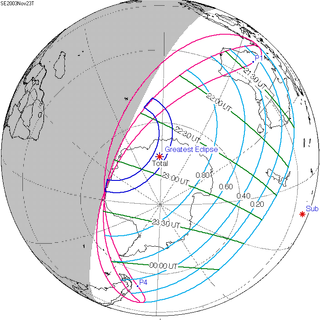| Solar eclipse of November 23, 2003 | |
|---|---|
 | |
| Type of eclipse | |
| Nature | Total |
| Gamma | −0.9638 |
| Magnitude | 1.0379 |
| Maximum eclipse | |
| Duration | 117 s (1 min 57 s) |
| Coordinates | 72°42′S 88°24′E / 72.7°S 88.4°E |
| Max. width of band | 495 km (308 mi) |
| Times (UTC) | |
| Greatest eclipse | 22:50:22 |
| References | |
| Saros | 152 (12 of 70) |
| Catalog # (SE5000) | 9516 |
A total solar eclipse occurred at the Moon's descending node of orbit between Sunday, November 23 and Monday, November 24, 2003,[1][2] with a magnitude of 1.0379. A solar eclipse occurs when the Moon passes between Earth and the Sun, thereby totally or partly obscuring the image of the Sun for a viewer on Earth. A total solar eclipse occurs when the Moon's apparent diameter is larger than the Sun's, blocking all direct sunlight, turning day into darkness. Totality occurs in a narrow path across Earth's surface, with the partial solar eclipse visible over a surrounding region thousands of kilometres wide. Occurring about 25 minutes before perigee (on November 23, 2003, at 23:15 UTC), the Moon's apparent diameter was near its maximum.[3] Perigee did occur just past the greatest point of this eclipse.
For most solar eclipses the path of totality moves eastwards. In this case the path moved south and then west round Antarctica.
Totality was visible from a corridor in eastern Antarctica. A partial eclipse was visible for parts of Australia, New Zealand, Antarctica, southern Chile, and southern Argentina.
- ^ "November 23–24, 2003 Total Solar Eclipse". timeanddate. Retrieved 11 August 2024.
- ^ "Eclipse of sun viewed on Antarctic for first time". Whitehorse Daily Star. 2003-11-24. p. 16. Retrieved 2023-10-25 – via Newspapers.com.
- ^ "Moon Distances for London, United Kingdom, England". timeanddate. Retrieved 11 August 2024.
